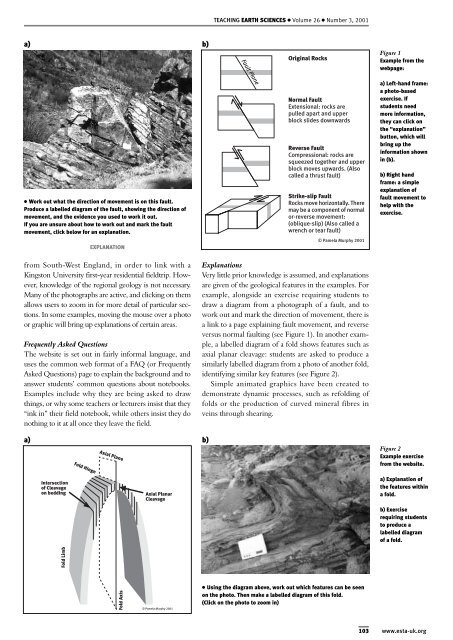teaching - Earth Science Teachers' Association
teaching - Earth Science Teachers' Association
teaching - Earth Science Teachers' Association
Create successful ePaper yourself
Turn your PDF publications into a flip-book with our unique Google optimized e-Paper software.
TEACHING EARTH SCIENCES ● Volume 26 ● Number 3, 2001<br />
a) b)<br />
Original Rocks<br />
Figure 1<br />
Example from the<br />
webpage:<br />
Fault Plane<br />
● Work out what the direction of movement is on this fault.<br />
Produce a labelled diagram of the fault, showing the direction of<br />
movement, and the evidence you used to work it out.<br />
If you are unsure about how to work out and mark the fault<br />
movement, click below for an explanation.<br />
EXPLANATION<br />
Normal Fault<br />
Extensional: rocks are<br />
pulled apart and upper<br />
block slides downwards<br />
Reverse Fault<br />
Compressional: rocks are<br />
squeezed together and upper<br />
block moves upwards. (Also<br />
called a thrust fault)<br />
Strike-slip Fault<br />
Rocks move horizontally. There<br />
may be a component of normal<br />
or-reverse movement:<br />
(oblique-slip) (Also called a<br />
wrench or tear fault)<br />
© Pamela Murphy 2001<br />
a) Left-hand frame:<br />
a photo-based<br />
exercise. If<br />
students need<br />
more information,<br />
they can click on<br />
the “explanation”<br />
button, which will<br />
bring up the<br />
information shown<br />
in (b).<br />
b) Right hand<br />
frame: a simple<br />
explanation of<br />
fault movement to<br />
help with the<br />
exercise.<br />
from South-West England, in order to link with a<br />
Kingston University first-year residential fieldtrip. However,<br />
knowledge of the regional geology is not necessary.<br />
Many of the photographs are active, and clicking on them<br />
allows users to zoom in for more detail of particular sections.<br />
In some examples, moving the mouse over a photo<br />
or graphic will bring up explanations of certain areas.<br />
Frequently Asked Questions<br />
The website is set out in fairly informal language, and<br />
uses the common web format of a FAQ (or Frequently<br />
Asked Questions) page to explain the background and to<br />
answer students’ common questions about notebooks.<br />
Examples include why they are being asked to draw<br />
things, or why some teachers or lecturers insist that they<br />
“ink in” their field notebook, while others insist they do<br />
nothing to it at all once they leave the field.<br />
Explanations<br />
Very little prior knowledge is assumed, and explanations<br />
are given of the geological features in the examples. For<br />
example, alongside an exercise requiring students to<br />
draw a diagram from a photograph of a fault, and to<br />
work out and mark the direction of movement, there is<br />
a link to a page explaining fault movement, and reverse<br />
versus normal faulting (see Figure 1). In another example,<br />
a labelled diagram of a fold shows features such as<br />
axial planar cleavage: students are asked to produce a<br />
similarly labelled diagram from a photo of another fold,<br />
identifying similar key features (see Figure 2).<br />
Simple animated graphics have been created to<br />
demonstrate dynamic processes, such as refolding of<br />
folds or the production of curved mineral fibres in<br />
veins through shearing.<br />
a) b)<br />
Fold Hinge<br />
Axial Plane<br />
Figure 2<br />
Example exercise<br />
from the website.<br />
Intersection<br />
of Cleavage<br />
on bedding<br />
Axial Planar<br />
Cleavage<br />
a) Explanation of<br />
the features within<br />
a fold.<br />
b) Exercise<br />
requiring students<br />
to produce a<br />
labelled diagram<br />
of a fold.<br />
Fold Axis<br />
Fold Limb<br />
© Pamela Murphy 2001<br />
● Using the diagram above, work out which features can be seen<br />
on the photo. Then make a labelled diagram of this fold.<br />
(Click on the photo to zoom in)<br />
103 www.esta-uk.org

















